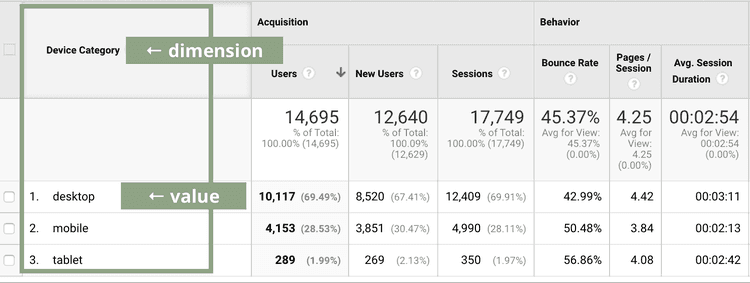Enhance Your Information Evaluation Making Use Of Secondary Dimension in Google Analytics
Checking out the abilities of secondary measurements in Google Analytics opens a world of possibilities for refining data analysis. By layering extra measurements onto primary information sets, a more complex narrative arises, dropping light on individual communications and performance indications.
Comprehending Second Dimensions
Second dimensions in Google Analytics refer to additional specifications that can be added to the main measurement, permitting for a much more thorough analysis of data (Secondary Dimension in Google Analytics). By integrating additional measurements, analysts can sector and filter information to reveal patterns, trends, and connections that could not be apparent when looking at the information as a whole.

Advantages of Utilizing Additional Dimensions
When assessing information in Google Analytics, the usage of additional dimensions offers invaluable insights right into user actions and performance metrics. By including a secondary measurement to your primary information, you can dig deeper right into the characteristics of your internet site site visitors and their interactions. Among the essential advantages of using second dimensions is the capability to segment and compare information better. This division allows you to understand exactly how various variables, such as demographics or traffic resources, impact individual actions and conversions (Secondary Dimension in Google Analytics).
Additionally, second dimensions help in identifying patterns and correlations that may not be immediately evident when considering the data alone. This deeper degree of analysis can reveal beneficial information that can assist advertising and marketing strategies, site optimization, and general business choices. Additionally, secondary measurements enhance the context of your primary data, offering a much more comprehensive sight of user engagement and performance metrics. In general, the use of additional dimensions in Google Analytics can considerably enhance the depth and top quality of your information evaluation, causing even more enlightened decision-making and boosted outcomes.
How to Include Second Dimensions
By incorporating second dimensions in Google Analytics, users can gain deeper understandings into their data evaluation process, permitting even more extensive assessment of customer actions and performance metrics. Including additional dimensions is an uncomplicated process that can considerably boost the depth of evaluation. To add a second measurement in Google Analytics, begin by browsing to the report you intend to evaluate. When in the record, find the "Secondary dimension" tab over the information table. Click on it to disclose a dropdown menu with different alternatives such as Habits, Modern Technology, and Customized Capacities. Select the measurement you intend to add, such as 'Source/Medium' or 'Gadget Category'. This additional measurement will then be related to your existing data, supplying extra context and allowing for a much more detailed evaluation of individual communications. By utilizing second find more measurements successfully, individuals can uncover useful understandings that may have otherwise been forgotten, leading to notified decision-making and boosted efficiency techniques.
Analyzing Data With Additional Measurements
Using additional dimensions in information evaluation gives a more detailed understanding of individual behavior and performance metrics. By adding a secondary measurement to your key data set in Google Analytics, you can dig deeper into the qualities of your site visitors and their interactions. Incorporating the main dimension of 'source/medium' with the secondary measurement of 'landing page' can reveal which specific web pages are bring in web traffic from various resources, aiding you optimize these web pages for far better involvement.

Basically, examining data with second measurements equips you to acquire beneficial insights right into individual behavior, identify fads, and make educated choices to improve the performance of your electronic homes.
Best Practices for Second Dimensions
In information analysis, incorporating additional dimensions properly can dramatically improve the depth of understandings stemmed from metrics and individual behavior patterns. When making use of secondary measurements in Google Analytics or any various other logical tool, it is important to stick to finest techniques to make sure the accuracy and importance of the information analysis.
One key best practice is to meticulously pick additional dimensions that match the primary measurement being analyzed. Selecting secondary measurements that provide extra context or further division can provide a more thorough understanding of the information. It is additionally necessary to stay clear of overcomplicating the analysis by including way too many secondary dimensions, which may bring about confusion or dilution of understandings.
Moreover, it is suggested to try out different mixes of main and secondary dimensions to uncover brand-new relationships and trends. On a regular basis assessing and improving the option of additional measurements based upon the specific objectives of i was reading this the analysis can cause more actionable insights. By following these best techniques, data experts can take advantage of secondary measurements effectively to enhance the total information analysis process and decision-making capabilities.

Conclusion
Finally, integrating second dimensions in Google Analytics is important for a comprehensive data evaluation method. great post to read By leveraging secondary measurements alongside primary ones, marketing experts and experts can discover beneficial insights and correlations that can educate decision-making and optimize digital marketing strategies. Understanding how to properly use secondary measurements and complying with ideal practices will certainly permit professionals to extract purposeful data and improve their total performance metrics.
Additional measurements in Google Analytics refer to additional specifications that can be added to the main dimension, enabling for an extra in-depth analysis of information. By incorporating secondary measurements, analysts can segment and filter information to reveal patterns, patterns, and correlations that could not be evident when looking at the information as a whole. Incorporating the primary dimension of 'source/medium' with the secondary measurement of 'landing page' can disclose which particular web pages are attracting traffic from different resources, aiding you enhance these web pages for far better engagement.
One key finest technique is to very carefully choose additional dimensions that enhance the main dimension being assessed. By following these ideal methods, data experts can utilize secondary measurements efficiently to enhance the total data evaluation process and decision-making capabilities.